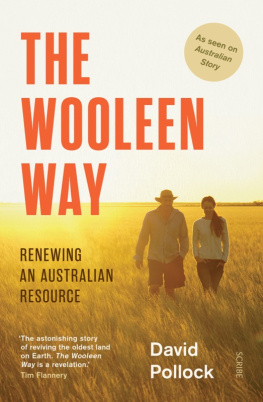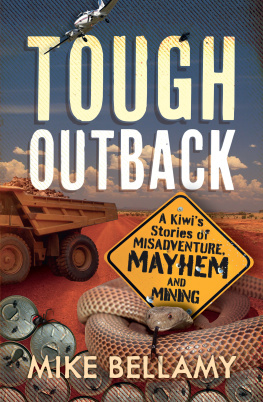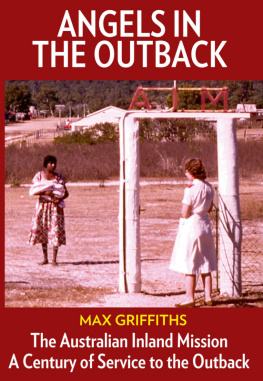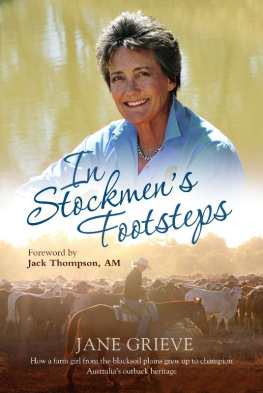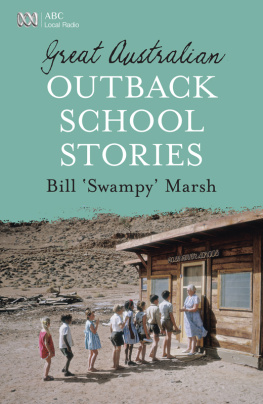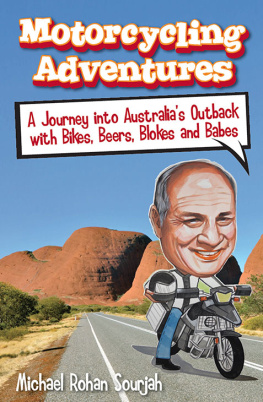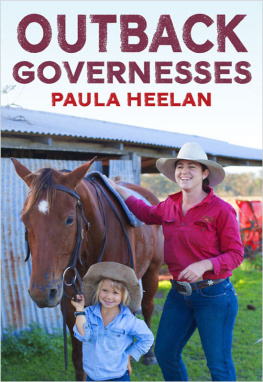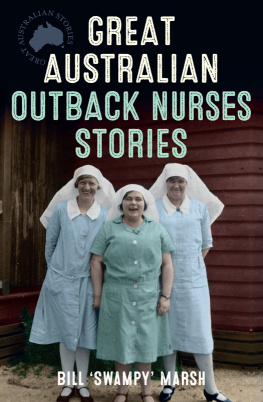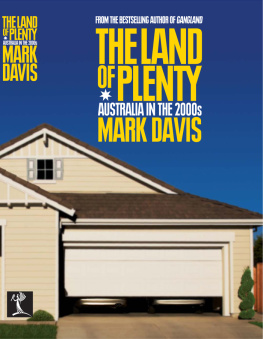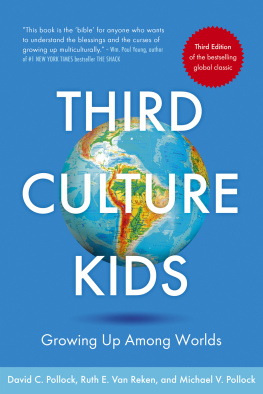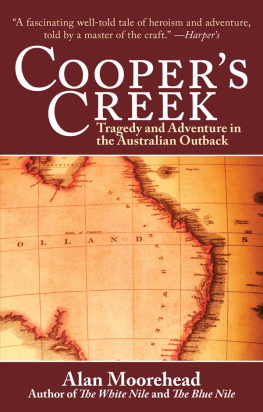
THE WOOLEEN WAY
David Pollock is a second-generation pastoralist from Wooleen Station in the Murchison region of Western Australia. He took over the 153,000-hectare property when he was 27, and was soon joined by his now wife Frances as they embarked on a quest to transform Wooleen into a sustainable grazing enterprise. They run a station-stay tourism business to help pay for repairing the ecological damage caused by historic overgrazing, and have appeared on the ABC TVs Australian Story program four times. David loves Frances, palatable perennial grass, Wooleen, their four kelpies, and happy cows. In that order.
Scribe Publications
1820 Edward St, Brunswick, Victoria 3056, Australia
2 John St, Clerkenwell, London, WC1N 2ES, United Kingdom
3754 Pleasant Ave, Suite 100, Minneapolis, Minnesota 55409, USA
First published by Scribe 2019
Copyright David Pollock 2019
All rights reserved. Without limiting the rights under copyright reserved above, no part of this publication may be reproduced, stored in or introduced into a retrieval system, or transmitted, in any form or by any means (electronic, mechanical, photocopying, recording or otherwise) without the prior written permission of the publishers of this book.
The moral rights of the author have been asserted.
9781925849257 (paperback edition)
9781925693898 (e-book)
A catalogue record for this book is available from the National Library of Australia.
scribepublications.com.au
scribepublications.com
This book is for all those affected by drought, past, present, and future. Particularly, my mother and father.
CONTENTS
CHAPTER 1
CHAPTER 2
CHAPTER 3
CHAPTER 4
CHAPTER 5
CHAPTER 6
CHAPTER 7
CHAPTER 8
CHAPTER 9
CHAPTER 10
CHAPTER 11
CHAPTER 12
CHAPTER 13
CHAPTER 14
CHAPTER 15
CHAPTER 16
CHAPTER 17
CHAPTER 18
CHAPTER 19
CHAPTER 20
CHAPTER 21
CHAPTER 22
CHAPTER 23
CHAPTER 24
CHAPTER 25
CHAPTER 26
CHAPTER 27
THE START
As I started getting a fire going, the birds were already about their business, announcing their intentions for the day. The sun was preparing itself on the horizon, somewhere below the outline of granite boulders that made up the oldest landscape on earth. I placed some twigs on the fire, and set the billy onto them.
The ashes from the previous night indicated we had lit a fire that was a bit too big. It was a little disrespectful, I thought, to have a fire that big disrespectful to the country. We had taken more than we needed from the landscape. But, for the English backpackers who were with us, campfires were a big attraction of camping, and they had revelled in the big fire. So, admittedly, had I.
Suddenly, a sound swept over the landscape, rolling over the mulga trees in the ancient Wajarri campsite. I looked towards Francess swag, and her sleepy head poked out from under the covers with a look of wonder on her face. I grinned at her and then looked in the direction of the sound, but saw only the mighty granite curve of Budara, the resting place of the elder of two brothers who had been killed by evil spirits in the Dreamtime. But then it appeared first the top of its head, and then the rest of its body. It trotted over the smooth rock until it saw us and stopped, but it was not surprised. It paused to look down on our little camp with the ashes and the billy smoking. Silhouetted on the granite dome in front of a sun that had not yet risen, the dingo lifted its head and howled again. It was a moment when I realised that the landscape had all the answers. I was just here to give it a chance.
Perhaps my very first memory is of Wooleen. I remember a steep, winding section of road, a large Bardi bush on the right, and a homestead nestled in a valley in the distance. It is significant that this memory includes a landscape and a particular geological feature that I have now devoted my life to protecting the Wooleen Lake. It is also the memory of a house, one that my family would long for, move into, love, grow in, move out, paint, and paint again.
My family used to visit Wooleen regularly because my father was best mates with the bloke who owned it at the time, Chris Sharpe. Also, we lived quite close (by Murchison standards) a mere half an hour away. My father had been coming to Wooleen since he was about the same age as I was when I formed this memory. His parents were good friends with the Sharpe family, and Dad would visit during school holidays. We still have the original visitors book where he wrote his name on an early visit, aged seven. Then his family moved to Melbourne.
In 1972, Dad returned to Wooleen as a jackeroo and worked his way up to become the bookkeeper for three stations: Wooleen, Twin Peaks, and Billabalong. It was at Billabalong station that Dad first met Mum, where she was working as a house girl. In those days, there were many people working on each station, and there were regular parties, tennis, picnics, and general get-togethers for social interaction. Now we just have Facebook with a slow internet connection.
In 1976, Mum and Dad moved to manage a station called Doorawarrah near Carnarvon, which today is only a few hours up the road from Wooleen. Back then, it took an endless half-day of bone-shaking corrugations in a Ford Customline station wagon that had been given to Mum and Dad as a wedding present. When they went to social occasions they took great lengths not to be seen arriving in it. My brother, Richard, preceded me by 18 months, and I arrived on the scene in 1980. Dad was offered a job with a pay packet he couldnt resist as shire clerk (CEO) for Murchison Shire, and so back to Wooleen we all went.
I say back to Wooleen, because the Murchison settlement is surrounded by Wooleen station, and it was a pretty isolated place. The term settlement probably conjures up images of sunburned Englishmen trying to trade beads with Aboriginals, but the term actually refers to the fact that Murchison was then, and remains today, the only shire in Australia without a town. It was from the Murchison settlement that my family used to visit Wooleen, 37 kilometres away. Or, if youd prefer to consider it, the second house on the left.
When we arrived in Murchison, ours was the only house, and one room of it was designated the shire office. The shire administration team consisted of Dad, as shire clerk, and Mum, as his personal assistant. As buildings went, there was also the sports hall, and Mum and Dad were expected to provide a large degree of organisational assistance to make sure that the facilities were ready for community functions. The rest of the community lived a long way away some, a distance of over 200 kilometres. Sport was limited to polocrosse, and clubs from around the state would converge for one weekend of the year. The next closest polocrosse club was at Mullewa, 200 kilometres away by dirt road. We also had an annual cricket match. Its still held every December, when it is 45C in the shade (and, of course, there is none of that on a cricket field). There is no grass, either just bare red dirt and a strip of concrete down the middle for a pitch.
The shire had seven employees, but at that stage they didnt have houses because they lived in caravans that travelled with them as they repaired roads. Communication, if there was any, was by radio. One of the grader drivers was a chap called Don Ketteringham, who was so tanned that his tattoos didnt show. He had a bough shed with a bed and a deep freezer in it close to our house, and we kids spent a lot of time over at his house. I guess if I had a grandfather figure early on in my life, it would have been him. He also had a missus, an Aboriginal woman called Daphne Flanagan, but she wasnt there all the time. Or at least she didnt seem to be.
Next page
